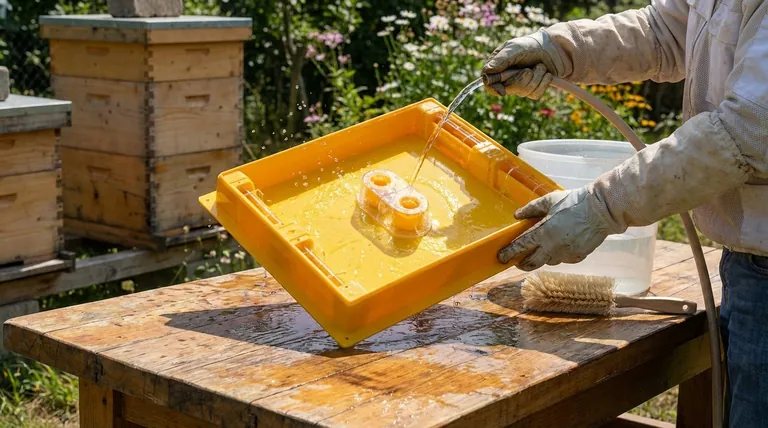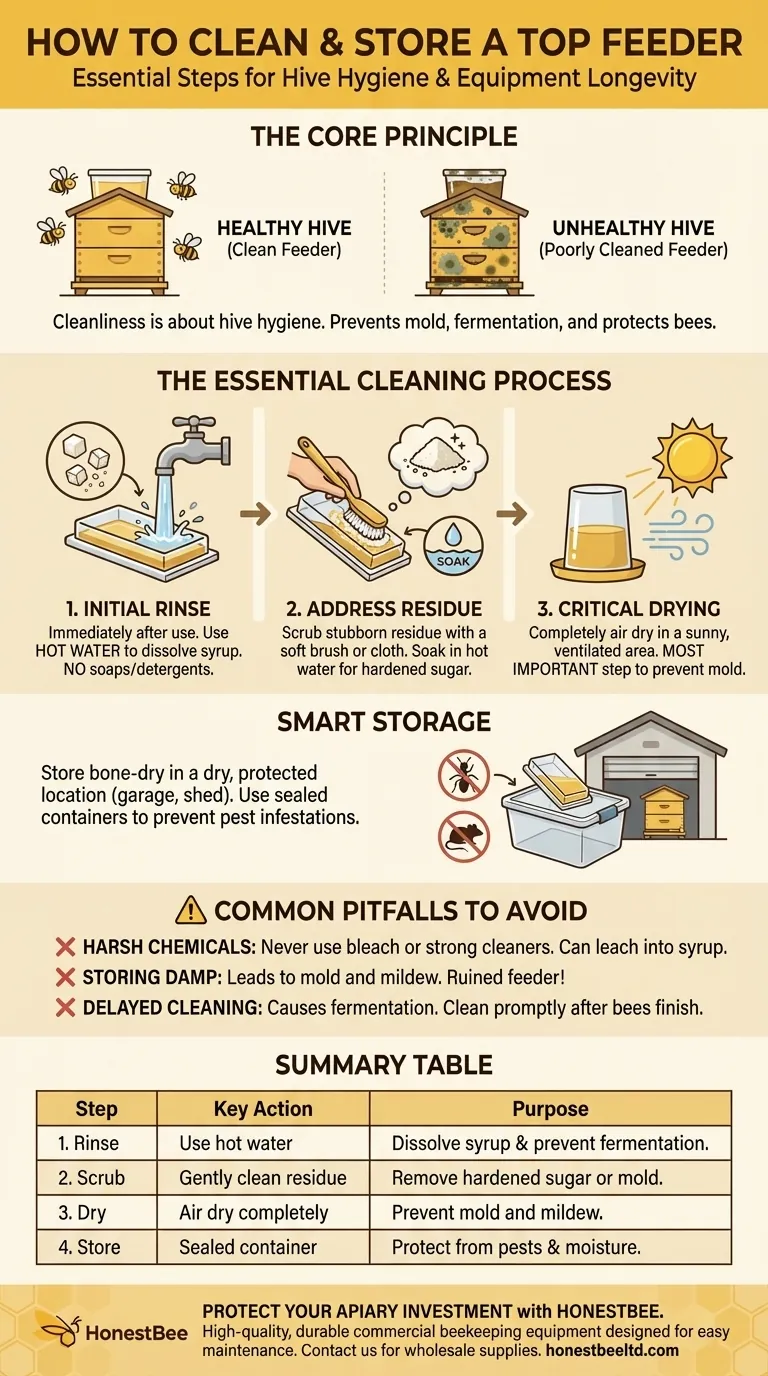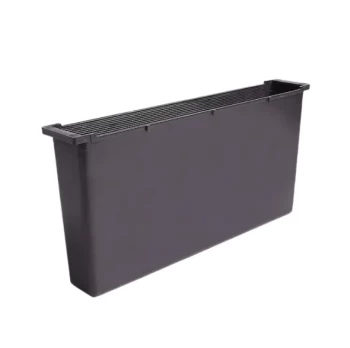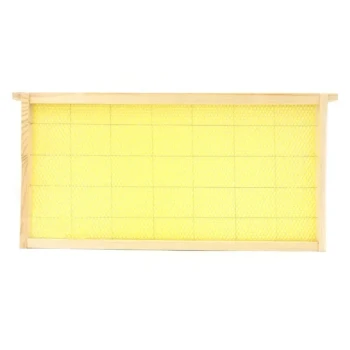To properly clean and store a top feeder, the essential steps are to rinse the syrup reservoir with water, ensure it is completely dry, and then stack it for storage. This simple process prevents mold growth and ensures the feeder is safe and ready for the bees the next time you need it.
The core principle behind cleaning and storing feeders is not just about tidiness—it's about hive hygiene. A poorly cleaned feeder can grow mold and ferment, which can harm your bees and contaminate future feedings.

The Essential Cleaning and Storing Process
Properly maintaining your equipment is a foundational aspect of responsible beekeeping. A clean feeder protects your investment and, more importantly, the health of your colony.
Step 1: The Initial Rinse
Immediately after the feeding period ends, your first step is to thoroughly rinse the feeder. Use hot water, as it is highly effective at dissolving any remaining sugar syrup or crystallized sugar.
For most routine cleaning, plain water is all you need. Avoid using soaps or detergents, as their residues can repel or even harm your bees.
Step 2: Address Any Stubborn Residue
If syrup has hardened or you notice the beginnings of mold, a simple rinse may not be enough. Use a soft brush or cloth to gently scrub the interior surfaces.
For particularly stubborn crystallized sugar, you can soak the feeder in hot water for an hour before scrubbing. This will typically loosen any residue without requiring harsh chemicals.
Step 3: The Critical Drying Stage
This is the most important step for preventing mold and mildew during storage. The feeder must be completely dry before you put it away.
Place the feeder in a sunny, well-ventilated area to air dry. Ensure all corners and crevices are free of moisture before moving to the final storage step.
Smart Storage to Protect Your Equipment
Once your feeder is clean and bone-dry, proper storage will protect it from pests and physical damage, ensuring it's ready for immediate use next season.
Choosing the Right Location
Store your feeders in a dry, protected location like a garage, shed, or basement. The goal is to keep them away from moisture and direct sunlight, which can degrade plastic over time.
Preventing Pest Infestations
Even a well-cleaned feeder can retain a faint sugary scent that attracts ants, mice, or other pests. Stacking them neatly is good, but placing them inside a sealed plastic tub or a tightly lidded container offers the best protection.
Common Pitfalls to Avoid
A few common mistakes can undermine your cleaning efforts and create problems for your bees down the line.
Using Harsh Chemicals
Never use bleach or strong household cleaners on your feeders. These substances can be absorbed by plastic and later leach into the syrup, posing a significant risk to your colony's health. Hot water is almost always sufficient.
Storing Feeders While Damp
Storing a feeder with even a small amount of moisture inside is an invitation for mold and mildew. This is the most common cause of a ruined feeder and can introduce harmful spores into your hive during the next feeding.
Forgetting to Clean Promptly
Leaving old syrup in a feeder on a warm day will cause it to ferment quickly. Always clean your feeders as soon as the bees have finished with them to make the job easier and more effective.
Final Recommendations for Feeder Maintenance
Your approach depends on whether you are doing a quick turnaround or preparing for long-term storage.
- If you are refilling the feeder within a day or two: A simple rinse with hot water to remove any debris is all that is required.
- If you are storing the feeder for the season: Follow the full process of rinsing, scrubbing if necessary, and ensuring it is completely dry before storing it in a pest-proof location.
Properly maintaining your feeding equipment is a simple task that pays dividends for the long-term health and productivity of your bees.
Summary Table:
| Step | Key Action | Purpose |
|---|---|---|
| 1. Rinse | Use hot water immediately after use. | Dissolves sugar syrup and prevents fermentation. |
| 2. Scrub | Gently clean stubborn residue with a soft brush. | Removes hardened sugar or mold without harsh chemicals. |
| 3. Dry | Air dry completely in a sunny, ventilated area. | Prevents mold and mildew growth during storage. |
| 4. Store | Place in a dry, sealed container in a protected area. | Protects from pests, moisture, and physical damage. |
Protect Your Apiary Investment with HONESTBEE
Proper equipment maintenance is key to a thriving colony. As a commercial beekeeper or distributor, you need durable, easy-to-clean supplies that stand up to rigorous use. HONESTBEE supplies high-quality, commercial-grade beekeeping equipment and feeders designed for easy maintenance and long-term durability.
Let us help you streamline your operations with reliable wholesale supplies. Contact our team today to discuss your apiary's needs and discover how our products can support your success.
Visual Guide

Related Products
- Professional Hive Top Bee Feeder for Beekeeping
- Rapid Bee Feeder White Plastic 2L Round Top Feeder for 8 or 10-Frame Bee Hives
- HONESTBEE Professional Hive Top Bee Feeder Feeding Solution
- HONESTBEE Entrance Bee Feeder Professional Hive Nutrition Solution for Beekeeping
- HONESTBEE Round Hive Top Bee Feeder for Syrup
People Also Ask
- What is a top feeder for bees? Maximize Colony Health with Efficient Feeding
- How to use a top feeder in a beehive? A Guide to Effective Beehive Feeding
- What is the best bee feeder for a hive? Choose the Right Feeder for Your Apiary's Scale
- What are the features of top feeders for bees? Maximize Hive Health with Safe, High-Capacity Feeding
- Do I need an inner cover with a hive top feeder? Optimize Your Hive Setup for Healthy Bees



















